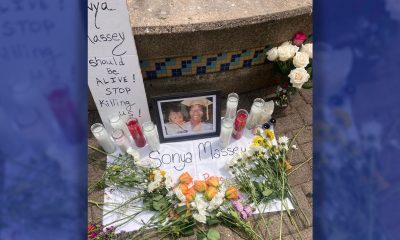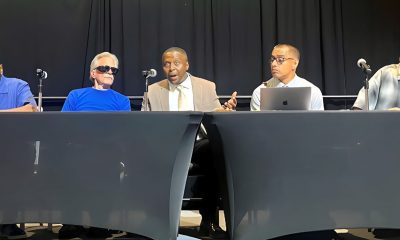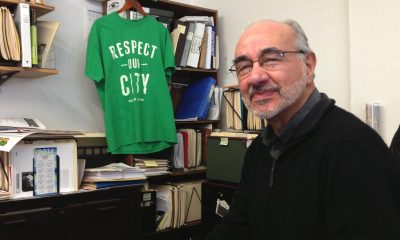Community
BART Police Respond to Alleged Dancing on Train, Arrest and Assault Young Woman
When 19-year-old Nubia Bowe was returning home on BART with friends on the evening of March 21, she had no idea that it would be the worst night of her life.
The evening ended up with her being accused by police of intimidating a witness and her friends being handcuffed for dancing on a BART train. She was slammed to the ground and struck repeatedly, arrested and sent to the county jail for four days. She now faces now four misdemeanors and was kicked out of school.
That’s what happened when BART police responded to a complaint that young men were dancing and soliciting money on a train at the Lake Merritt station. Bowe and her friends, who had not seen anyone dancing on the train, were picked out as the culprits by one witness, who later recanted.
However, her friends were handcuffed and detained, even though a train full of witnesses repeatedly told police the young people were not the perpetrators.
But the arrest was the only the beginning of the ordeal. Bowe was slammed to the ground, handcuffed and accused of resisting arrest, among other charges.
When she reached the county jail at Santa Rita, she says officers beat her for allegedly attacking one of the guards, and she was put in restraints, similar to a straight jacket. She was placed in a wrap which had handcuffs attached and a belt connecting her upper body to her ankles.
As a result of the arrest, was kicked out of her training program at Treasure Island Job Corps.
When contacted by the Oakland Post, BART spokesperson Alicia Trost forwarded the police log, which stated, “A BART sergeant and officer were flagged down on a complaint of patrons on a train dancing, playing music and creating a disturbance.
“They did not cooperate and became combative. One suspect bit one officer causing a moderate laceration on his left arm. Two suspects were cited and released, one was booked into the Alameda County Jail.”
“If there are any reports of police misconduct, we encourage people to contact our Office of the Independent Police Auditor, who will conduct an investigation,” said Trost.
By press time, the Alameda County Sheriff’s Office had not responded to the Post’s questions.
The March 21 incident began when BART officers responded to a complaint that two young, male dancers were soliciting for money on the train. The two men who were accompanying Bowe were approached by the officers at the Lake Merritt station, with a witness who at first identified the young men as the suspects.
The men were instructed by the officers to get off the train for questioning. During the questioning, train riders told the officers that the three suspects had not engaged in the solicitation of passengers and that young people they were looking for had already left the train at the West Oakland station.
“We were on the train minding our own business when a man entered the train with two BART officers and told them it was us,” said Levi Allen, one of Bowe’s friends. “The guy came from a different car, and we had never seen him before.”
Bowe and her two friends are African American. She was a full-time student at a local security-training program. Repeatedly trying to explain that her friends were innocent, she told the officers that they were violating the young men’s rights.
By this time, BART passengers were loudly calling out to the officers, saying the young people were innocent, and the police forcibly removed Bowe from the train.
The witness who had initially identified Bowe and her friends as the perpetrators later told officers they weren’t the right group.
“Once they pulled me off the train, I was first slammed to the ground and then thrown against the wall,” said Bowe. “The officers pushed me back down and continued to elbow and knee me in my back. My mouth was full of blood by then. The whole time this was happening, I repeatedly said ‘I am not resisting arrest. You are violating my civil rights.’”
When Bowe’s friends protested the young woman’s treatment, they were taken upstairs away from the conflict. Some of the passengers recorded the confrontation on their cell phones showing footage of Bowe pinned down by officers while screaming for help.
Bowe was taken to the Lake Merritt station holding cell in preparation for transport to Santa Rita Jail on one felony and three misdemeanor charges.
When she arrived at Santa Rita, she was taunted, battered and denied medical care, as well as the right to make a phone call for three days. Bowe is 5’1” and weighs 105 pounds.
“Three male guards and one female guard came in my cell and beat me up,” said Bowe. “They hit me and then said that I assaulted one of them. So they chained my wrists to my ankles and tipped me over onto the urine-soaked ground so I couldn’t get up.
“I could tell they were trying to break my spirit.”
She was in custody for four nights. Her bail was set at $120,000.
Though the felony charge was eventually dropped, the arrest resulted in Bowe being kicked out of her training program, where she was only two months away from graduating.
“This case represents another example of racial profiling by BART police,” said civil-rights Attorney Dan Siegel, who represents Bowe. “Although the end isn’t as tragic, its similar to the Oscar Grant case. Some person made a complaint about dancing on BART, Nubia and her friends were not the people dancing, and yet, she still faces two sets of charges for allegedly fighting with police and resisting arrest.”
In light of the charges, Bowe’s family and friends have started a group against police brutality called the One Shot Away Coalition. The coalition is saying that people of color are all one shot away from incarceration and/or death.
A trial date on the BART charges has been set for Aug. 5, and the pre-trial hearing on the Santa Rita charges is scheduled for May 19.
“She will forever have to deal with the trauma of her experiences,” said Carroll Fife, Bowe’s godmother. “We want justice for Nubia and those young men who were cuffed, detained, cited and released. They were not read their rights. The district attorney is pressing for jail time, so we have to get prepared for a long fight with help from the community to get the word out.”
Anyone who has information about the case or who wishes to learn more should go to www.facebook.com/oneshotawayba?fref=ts.
Video from the arrest at Lake Merritt BART station can be viewed here: https://www.youtube.com/watch?v=kO2myBE5Qe0.
Activism
An Inside Look into How San Francisco Analyzes Homeless Encampments
Dozens of unhoused people are camped at Sixth and Jesse streets in San Francisco’s South of Market neighborhood. Tents made of tarps and blankets, piles of debris, and people lounging alongside the allies and walls of businesses are seen from all angles. These are some of the city’s hotspots. City crews have cleared encampments there over 30 times in the past year, but unhoused people always return.

By Magaly Muñoz
Dozens of unhoused people are camped at Sixth and Jesse streets in San Francisco’s South of Market neighborhood. Tents made of tarps and blankets, piles of debris, and people lounging alongside the allies and walls of businesses are seen from all angles.
These are some of the city’s hotspots. City crews have cleared encampments there over 30 times in the past year, but unhoused people always return.
But it’s normal to have tents set up again within less than 24 hours after an encampment sweep, David Nakanishi, Healthy Streets Operation Center Manager at the Department of Emergency Management, says. Sometimes there’s less people than before but often there is also no change.
“Most of the people that were in the encampments that want to go inside, we’ve gotten the majority of those [into shelter],” Nakanishi says. “Many of the people we encounter now, are those who have various reasons to not accept shelter, and some are already in shelter/housing”.
Since the ruling of Grants Pass by the US Supreme Court earlier this summer, which allows cities the authority to ban people from camping or sleeping on the streets, San Francisco has been at the head of the conversation to crack down on encampments.
Where neighboring cities in the Bay Area are clearing encampments a few days a week, San Francisco is sweeping 10 times a week, two per weekday.

David Nakanishi, Healthy Streets Operation Center Manager at the San Francisco Department of Emergency Management, makes a 311 report on an encampment in the Mission District. These reports allow smaller city teams to tackle individual spots where unhoused people frequent. Photo by Magaly Muñoz.
Considering the controversy that plagues the city around its harsh policies, the Post decided to tag along on a ride with Nakanishi to show us how he decides what encampments make it on the city’s sweep list.
Nakanishi, having over 20 years of experience in homelessness management, drives around the busiest parts of the city almost daily. He’s tasked with arranging a weekly sweeping operation schedule for city teams to engage with unhoused folks to help get them off the streets.
So what exactly is he looking out for when deciding what encampments get swept?
It depends, he says.
Locations like schools, recreational centers, senior centers, or businesses are places he tends to want to address quickly, especially schools. These are the places where the complaints are highest and access to facilities is important for residents.
He says he also takes into account 311 calls and reports made to him by city staff. On the date of publication, over 100 calls and reports were made about encampments around the city, according to San Francisco data.

Makeshift structures built from plywood and tarps are starting to pop up more throughout the city. Certain areas under freeways are not under direct authority from San Francisco, making it harder to sweep these encampments. Photo by Magaly Muñoz.
Nakanishi made a few 311 reports himself on the ride along, pulling over to take photos and describe the encampments into his 311 app. He says it helps him remember where to possibly sweep next or allows smaller teams in the city to engage quicker with individuals on the streets.
Nakanishi also looks at the state of the encampments. Are there a lot of bulky items, such as furniture, or makeshift structures built out of tarps and plywood, blocking areas of traffic? Is trash beginning to pile up and spill into the streets or sidewalks? Sites that meet this criteria tend to be contenders for encampment sweeps, Nakanishi says.
Street by street, he points out individuals he’s interacted with, describing their conditions, habits, and reasons for denying assistance from the city.
One man on 2nd St and Mission, who rolls around a blue recycling bin and often yells at passing pedestrians, has refused shelter several times, Nakanishi says.
People deny shelter for all kinds of reasons, he says. There’s too many rules to follow, people feel unsafe in congregate or shared shelters, or their behavioral and mental health problems make it hard to get them into proper services.

Inside a tent left by an unhoused man on Stevenson and 14th Street in San Francisco. The area smelled of human waste and leftover alcohol. Photo by Magaly Muñoz.
Nakanishi references another man on South Van Ness under the freeway, who city outreach have attempted to get into shelter, but his screaming outbursts make it difficult to place him without disturbing other people in the same space. Nakanishi says it might be an issue of the man needing resources like medication to alleviate his distress that causes the screaming, but the city behavioral team is in the process of outreaching him to figure that out.
In October, city outreach teams engaged with 495 unhoused people. 377 of those engaged refused shelter and only 118 accepted placements, according to city data. That number of monthly referrals is consistent throughout the entirety of 2024 so far.
Nakanishi has long advocated for the well-being of unhoused people, he explains. In 2004, he was working with the Department of Public Health and told then-Mayor Gavin Newsom that there needed to be more housing for families. Nakinishi was told it was easier to deal with individuals first and the city “will get there eventually.” 20 years later, family housing is still not as extensive as it could be, and the waiting list to get placements for families is a mile long with over 500 names.
In 2020, he was a Senior Behavioral Health Clinician at a hotel in the city during the pandemic. He says in 2021 he collaborated with DPH to provide vaccines to those staying in the makeshift hotel shelters once those became available.

Nakanishi strips apart a solo tent on Stevenson and 14th Street in San Francisco. He discards items, like tarps and cardboard, so that people cannot reuse them to make another sleeping structure. Photo by Magaly Muñoz.
Despite the constant media attention that city outreach is inhumanely treating homeless people, so much so that it has led to lawsuits against San Francisco from advocates, Nakanishi says not a lot of people are seeing the true conditions of some encampments.
He describes soiled clothing and tents, drenched in urine, and oftentimes rodents or bug infestations in places where people are sleeping. He’s asked homeless advocates- often those who are the most critical about the city’s work- who have shown up to observe the sweeps if those are conditions the city should allow people to be subjected to, but not many have answers for him, Nakanishi says.
The city’s “bag and tag” policy allows city workers to throw away items that are “soiled by infectious materials” such as bodily fluids and waste.
Sweep operations are conducted at 8am and 1pm Monday through Friday. People at the encampments are given 72 hour notice to vacate, but some don’t leave the area until the day of the sweep.
City outreach workers come out the day before and day of to offer resources and shelter to those interested. The Department of Public Works discards any trash that is left over from the sweep and washes down the area.
Nakanishi told the Post that the only time the city takes tents or personal possessions from residents is when folks become physically violent towards workers and police take the items as evidence. Other items taken are bagged and tagged in accordance with city policy.
Stories from local newspapers such as the San Francisco Standard and the Chronicle show instances of SFPD handcuffing residents while their items are thrown in the trash or disposing of personal possessions without reason.
Advocates have long been pushing for a more competent and compassionate process if the city is going to choose to continue sweeping unhouse people.
No matter the lawsuits and constant criticisms from allies, the encampment sweeps are not slowing down, even with the cold weather quickly approaching the coastal city.
Nakanishi says there aren’t a lot of large encampments left in San Francisco so now they do runs of streets in order to stretch out the sweeps as much as possible.
It’s calculated strategies and years of first hand knowledge that make this job work, “It takes dedication to the work, caring for the people and the community, and persistence, patience and sometimes good luck to make the positive changes for the people on the street,” Nakanishi says.
Activism
Oakland Post: Week of November 13 – 19, 2024
The printed Weekly Edition of the Oakland Post: Week of November 13 – 19, 2024

To enlarge your view of this issue, use the slider, magnifying glass icon or full page icon in the lower right corner of the browser window. ![]()
Activism
LIVE! — TOWN HALL ON RACISM AND ITS IMPACT — THURS. 11.14.24 5PM PST
Join us for a LIVE Virtual Town Hall on the Impact of Racism hosted by Post News Group Journalist Carla Thomas and featuring Oakland, CA NAACP President Cynthia Adams & other Special Guests.
Thursday, November 14, 2024, 5 p.m. – 6:30 p.m. PST

Join us for a LIVE Virtual Town Hall on the Impact of Racism hosted by Post News Group Journalist Carla Thomas and featuring Oakland, CA NAACP President Cynthia Adams & other Special Guests.
Thursday, November 14, 2024
5 p.m. – 6:30 p.m. PST
Discussion Topics:
• Since the pandemic, what battles have the NAACP fought nationally, and how have they impacted us locally?
• What trends are you seeing concerning Racism? Is it more covert or overt?
• What are the top 5 issues resulting from racism in our communities?
• How do racial and other types of discrimination impact local communities?
• What are the most effective ways our community can combat racism and hate?
Your questions and comments will be shared LIVE with the moderators and viewers during the broadcast.
STREAMED LIVE!
FACEBOOK: facebook.com/PostNewsGroup
YOUTUBE: youtube.com/blackpressusatv
X: twitter.com/blackpressusa
-

 Alameda County4 weeks ago
Alameda County4 weeks agoAlameda County District Attorney Pamela Price Announces $7.5 Million Settlement Agreement with Walmart
-

 Activism3 weeks ago
Activism3 weeks ago‘Jim Crow Was and Remains Real in Alameda County (and) It Is What We Are Challenging and Trying to Fix Every Day,’ Says D.A. Pamela Price
-

 Bay Area3 weeks ago
Bay Area3 weeks agoIn the City Attorney Race, Ryan Richardson Is Better for Oakland
-

 Activism3 weeks ago
Activism3 weeks agoOakland Post: Week of October 30 – November 5, 2024
-

 Alameda County3 weeks ago
Alameda County3 weeks agoD.A. Price Charges Coliseum Flea Market Vendors in Organized Retail Theft Case
-

 Activism3 weeks ago
Activism3 weeks ago‘Criminal Justice Reform Is the Signature Civil Rights Issue of Our Time,’ says D.A. Pamela Price
-

 Activism3 weeks ago
Activism3 weeks ago“Two things can be true at once.” An Afro-Latina Voter Weighs in on Identity and Politics
-

 Arts and Culture3 weeks ago
Arts and Culture3 weeks agoMacArthur Fellow Jericho Brown’s Poetry Reflects Contemporary Culture and Identity























































